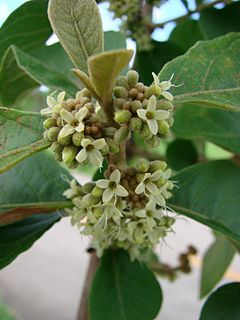
Salim Ali's fruit bat is a rare megabat species in the monotypic genus Latidens. It was first collected by Angus Hutton, a planter and naturalist in the High Wavy Mountains in the western ghats of Theni district, Tamil Nadu in South India in 1948. It was originally misidentified as a short-nosed fruit bat (Cynopterus) but later identified by Kitti Thonglongya as a new species and was named after Indian ornithologist Salim Ali in 1972.
Aegiphila sellowiana is a species of tree or shrub in the family Lamiaceae. It is native to Bolivia, Brazil, and Ecuador. Its common names include tamanqueira.

Aegiphila lhotskiana is a species of flowering plant in the family Lamiaceae. It is native to South America, where it occurs in Bolivia and Brazil. This species is cited in Flora Brasiliensis by Carl Friedrich Philipp von Martius.
Dalbergia glomerata is a species of legume in the family Fabaceae. It is found only in Mexico.

Aegiphila is a genus of flowering plants in the mint family, Lamiaceae, first described in 1763. It was formerly classified in the Verbenaceae. It is native to Mexico, Central America, South America, the West Indies, and Florida.
Aegiphila fasciculata is a species of tree in the family Lamiaceae. It is native to Central America, where it occurs in Guatemala, Honduras, and Nicaragua. It grows in humid forest habitat.

Aegiphila ferruginea is a species of flowering plant in the family Lamiaceae. It is endemic to Ecuador. It occurs in the high Andes between 2000 and 4000 meters in elevation, where it grows in cloud forest. There are about 15 wild populations known. It is a shrub or tree that grows easily in disturbed habitat and it can be a common roadside plant in some areas. It is also cultivated on a small scale.
Aegiphila monticola is a species of tree in the family Lamiaceae. It is endemic to Ecuador, where it is known from Cotopaxi and Bolívar Provinces. There are about eight populations.
Aegiphila panamensis is a species of flowering plant in the family Lamiaceae. It is native to the Americas, its distribution extending from Mexico to Colombia.
Aegiphila purpurascens is a species of tree in the family Lamiaceae. It is endemic to Azuay Province in Ecuador, where only three populations are known. It grows in the cloud forests of the Andes at 2000 to 3000 meters in elevation.
Aegiphila rimbachii is a species of tree in the family Lamiaceae. It is endemic to Bolívar Province in Ecuador, where it grows in the cloud forests of the Andes.
Aegiphila schimpffii is a species of tree in the family Lamiaceae. It is endemic to Ecuador, where it is known from five populations. It occurs in coastal forest habitat and foothills up to 1000 meters in elevation.
Aegiphila skutchii is a species of flowering plant in the family Lamiaceae. It is native to Guatemala, Honduras, and Mexico.
Aegiphila sordida is a species of flowering plant in the family Lamiaceae. It is endemic to Peru.
Ardisia glomerata is a species of plant in the family Primulaceae. It is endemic to Panama.
Knema glomerata is a species of plant in the family Myristicaceae. It is a tree found in Borneo, the Moluccas and the Philippines.
Ternstroemia glomerata is a species of plant in the Pentaphylacaceae family. It is endemic to Jamaica. It is threatened by habitat loss.
Ochrosia glomerata is a species of tree in the family Apocynaceae.
Aegiphila caymanensis is a species of mint endemic to Grand Cayman. It is a scrambling shrub with one rooting point, it is inconspicuous when not in flower. This species is probably extinct; the last known specimen was bulldozed in August 2015.
Aegiphila monstrosa is a species of flowering plant in the family Lamiaceae. It is found in Belize, Guatemala, Honduras, and Mexico. It is threatened by loss of habitat to agriculture.




